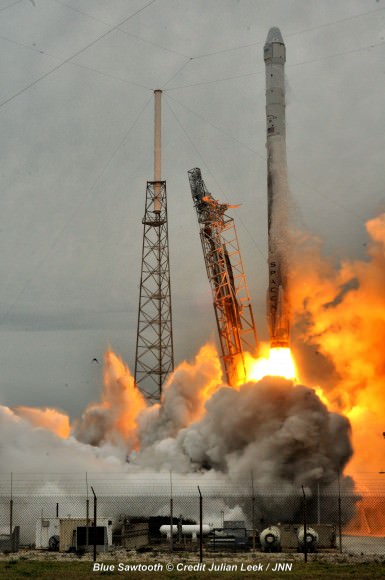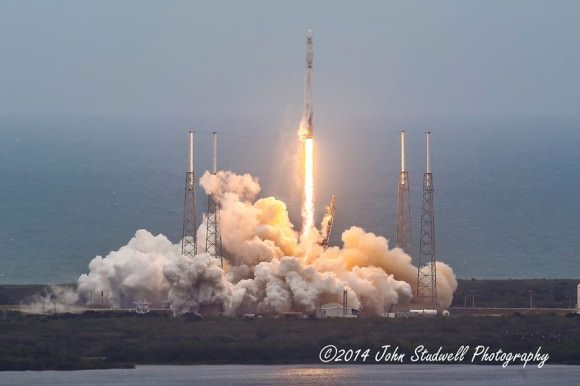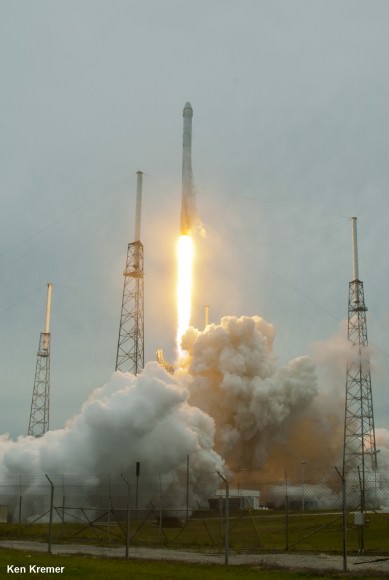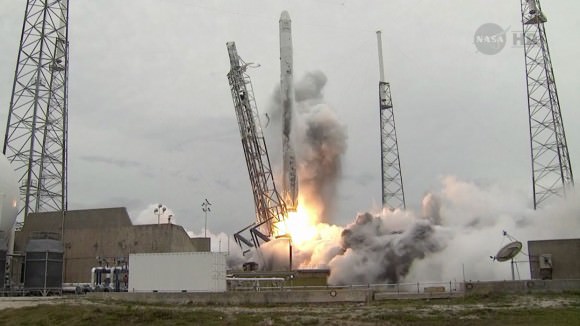Host: Fraser Cain (@fcain)
Guests: Morgan Rehnberg (cosmicchatter.org / @cosmic_chatter), Nancy Atkinson (@Nancy_A)
Continue reading “Weekly Space Hangout – May 2, 2014: Gas Clouds & Photobombs”
Court Injunction Blocks Russian Engine Purchase by ULA for US National Security – Win for SpaceX Yields Uncertainty
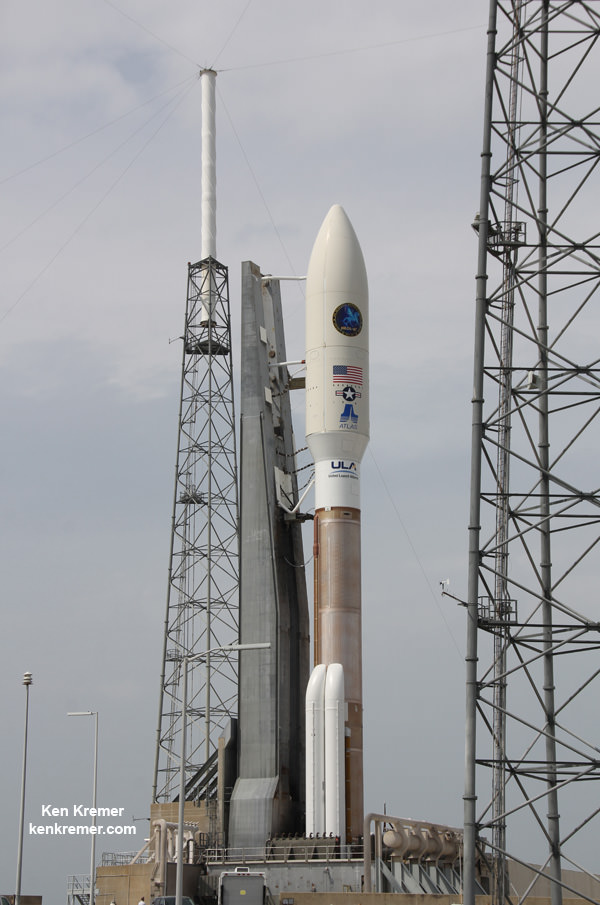
United Launch Alliance Atlas V rocket – powered by Russian made RD-180 engines – and Super Secret NROL-67 intelligence gathering payload poised for launch at Space Launch Complex 41 at Cape Canaveral Air Force Station, FL, in March 2014. Credit: Ken Kremer – kenkremer.com
Story updated[/caption]
A US Federal Court has now issued a preliminary injunction that blocks the purchase and importation of Russian rocket engines by United Launch Alliance (ULA) for its Atlas V rocket used in National Security launches for the US Air Force after a filing by SpaceX. But what are the implications?
The US Federal Court of Federal Claims order was issued late Wednesday, April 30, by US Judge Susan G. Braden of the US Court of Federal Claims. The court order is in response to a protest filed by SpaceX against ULA and the US Air Force relating to the uncontested $11 Billion “block buy” launch contract purchase in December of 36 rocket cores for US National Security launches and is also related to US sanctions imposed after Russia’s recent actions in Ukraine and seizing and annexing the Crimea.
The temporary injunction marks a big win for SpaceX but immediately throws future National Security spy satellite and NASA science launches into uncertainty and potential disarray as I reported previously – here and here.
As I posted here last Friday, April 25, SpaceX CEO Elon Musk declared his firms intent to file suit against ULA and the Air Force on Monday, April 28 to break the launch monopoly.
Judge Braden’s injunction followed barely two days later.
Musk said the recent ‘block buy’ launch contract was unfair in blocking SpaceX from competing for launches of surveillance satellites, would cost taxpayers billions of extra dollars in coming years and should be recompetited.
“The national security launches should be put up for competition and they should not be awarded on a sole source, uncompeted basis,” Musk said at the April 25 briefing at the National Press Club in Washington, DC.
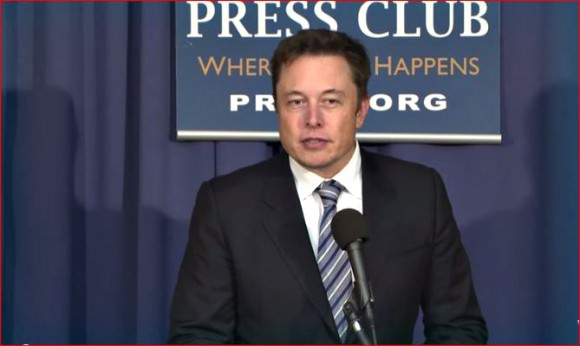
ULA quickly vowed today that they will respond to resolve the injunction and further stated that “This opportunistic action by SpaceX … ignores the potential implications to our National Security.”
Federal Judge Braden’s order specifically states the following; “The preliminary injunction prohibits the United States Air Force and United Launch Alliance, from making any purchases from or payment of money to NPO Energomash or any entity, whether governmental, corporate or individual, that is subject to the control of Deputy Prime Minister Rogozin.”
“IT IS SO ORDERED,” wrote Braden.
The engines at the heart of the Federal preliminary injunction are the RD-180 liquid fueled engines which power ULA’s Atlas V rocket and are manufactured in Russia by NPO Energomash – which is majority state owned by the Russian Federation and subject to the control of Russian Deputy Prime Minister Rogozin, who is specifically named on the US economic sanctions target list.
In response, Rogozin said that sanctions could “boomerang” against the US space program. He said that perhaps NASA should “deliver their astronauts to the International Space Station using a trampoline.”
Thanks to the utter folly of US politicians in shutting down the Space Shuttle program before a replacement crew vehicle was available and repeatedly slashing NASA’s commercial crew budget, American astronauts are now 100% dependent on the Russian Soyuz capsule for rides to the ISS and back for several more years ahead.
NASA has NO immediate alternatives to Russia’s Soyuz – period.
The rocket engine injunction is just the latest fallout impacting a vast swath of US space programs from National Defense to NASA stemming from the dangerously escalating crisis between Ukraine and the Russian Federation in the worst confrontation with the West since the Cold War era.
In response to the worsening Ukraine crisis, Western nations have instituted waves of increasingly harsh economic sanctions against Russia and several key members of the Russian government.
Judge Braden’s injunction stands until she receives clarification otherwise from US government entities that the engine purchase is not covered by the Federal government santions.
The order remains in effect “unless and until the court receives the opinion of the United States Department of the Treasury, and the United States Department of Commerce and United States Department of State, that any such purchases or payments will not directly or indirectly contravene Executive Order 13,661.”
ULA issued a swift statement today – received by Universe Today – from ULA’s general counsel Kevin G. MacCary, in response to Judge Braden’s preliminary injunction.
“ULA is deeply concerned with this ruling and we will work closely with the Department of Justice to resolve the injunction expeditiously. In the meantime, ULA will continue to demonstrate our commitment to our National Security on the launch pad by assuring the safe delivery of the missions we are honored to support.”
“SpaceX’s attempt to disrupt a national security launch contract so long after the award ignores the potential implications to our National Security and our nation’s ability to put Americans on board the International Space Station.”
The Atlas V rocket, powered by the Russian made RD-180 engines, will also be used as the launch vehicle by two of the three companies vying for the next round of commercial crew contracts aimed at launching US astronauts to the ISS. The contracts will be awarded by NASA later this year.
“This opportunistic action by SpaceX appears to be an attempt to circumvent the requirements imposed on those who seek to meet the challenging launch needs of the nation and to avoid having to follow the rules, regulations and standards expected of a company entrusted to support our nation’s most sensitive missions,” said ULA.
ULA is a joint venture between aerospace giants Boeing and Lockheed Martin, formed in 2006. It has conducted 81 consecutive launches with 100% mission success – including many NASA science and mission probes like Orion EFT-1, Curiosity, MAVEN, TDRS and more.
Judge Braden furthermore made clear that her order did not include prior RD-180 engine purchases.
“The scope of this preliminary injunction does not extend to any purchase orders that have been placed or moneys paid to NPO Energomash prior to the date of this
Order [April 30, 2014].”
ULA has a two year contingency supply of the RD-180’s and blueprints to begin production, if needed.
However in the event of a cutoff by Russia or US court injuncions, it would take ULA at least three to five years to start and certify RD-180 engine production somewhere in the US, a ULA spokesperson told me recently at Cape Canaveral.
This possibly leaves a 1 to 3 year gap with no Atlas V 1st stage engine supply.
SpaceX claims they can fill part of the launch gap. But their Falcon rockets are not yet certified for National Security launches.
“So far we are most of the way through the certification process. And so far there have been zero changes to the rocket. Mostly it’s just been a paperwork exercise.”
“In light of international events, this seems like the wrong time to send hundreds of millions of dollars to the Kremlin,” said Musk during the April 25 press briefing at the National Press Club in Washington, DC.

Watch for my continuing articles as the Ukraine crisis escalates and court orders fly – with uncertain and potentially dire consequences for US National Security and NASA.
Stay tuned here for Ken’s continuing SpaceX, Orbital Sciences, commercial space, Orion, Chang’e-3, LADEE, Mars rover, MAVEN, MOM and more planetary and human spaceflight news.
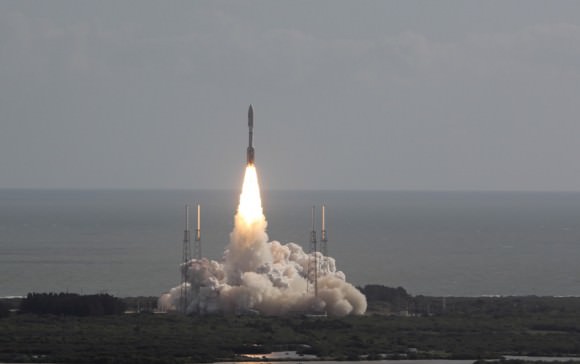
Credit: Ken Kremer – kenkremer.com
SpaceX Releases Raw Video of First Stage Landing Attempt
Video released today by SpaceX confirms the landing legs deployed successfully on the Falcon 9’s first stage booster, paving the way for future vertical soft touchdowns on land. SpaceX’s next-generation Falcon 9 rocket was tested following the launch of the CRS-3 mission for the Dragon spacecraft, which launched from Cape Canaveral Air Force Station on April 18. This was the first test of the landing legs deployment with a re-entry burn and soft landing in the Atlantic Ocean.
The SpaceX CEO had mentioned the success during a post launch briefing and later tweeted further updates that the Falcon 9 first stage actually made a good water landing despite rough seas, with waves swelling at least six feet. He also spoke briefly of the success during a news conference at the National Press Club on April 25, saying video would be released soon.
The video above is actually a cleaned-up (repaired) version of the original. There are a short few frames which show the landing legs deployed just before splashdown, which Musk highlighted in a recent Tweet. Obviously this is not the greatest-quality video ever released, but exciting still the same. SpaceX is actually looking for help in cleaning up the video even further.
SpaceX CEO Elon Musk Sues Government to Break US Air Force’s National Security Launch Monopoly

SpaceX CEO Elon Musk announces lawsuit protesting Air Force launch contracts while speaking at the National Press Club in Washington, DC on April 25, 2014
Story updated[/caption]
Elon Musk, CEO and founder of the upstart commercial launch venture SpaceX, announced at a press conference today, Friday, April 25, that SpaceX is filing suit against the Federal Government to protest and break the US Air Force’s awarding of lucrative launch contracts for high priority national security satellites to a sole rocket provider – United Launch Alliance (ULA) – on a non competitive basis.
The gloves are officially off in the intensely mounting duel over multibillion dollar Air Force military launch contracts between SpaceX and ULA.
“The official protest document will be available Monday, April 28th at www.freedomtolaunch.com and will be filed with the United States Court of Federal Claims in Washington, D.C.,” said SpaceX in an official statement.
Musk said the Air Force launch contract with ULA amounted to a continuing monopoly, was unfair by blocking SpaceX from competing for launches of surveillance satellites and would cost taxpayers billions of extra dollars in coming years.
“What we feel is that this is not right – that the national security launches should be put up for competition and they should not be awarded on a sole source, uncompeted basis,” said Musk at the briefing called on short notice and held at the National Press Club in Washington, DC.
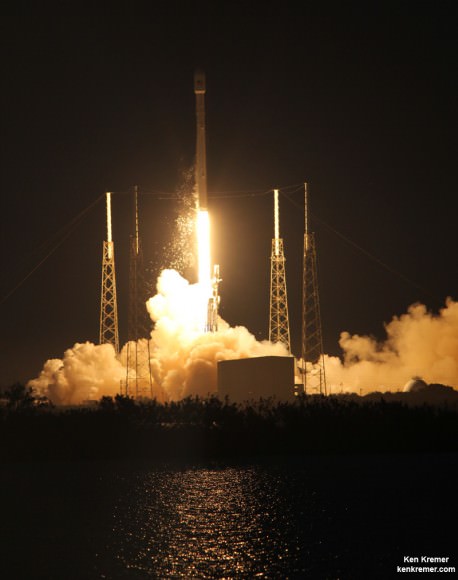
The latest Air Force launch contract dated to December 2013 guarantees the “block buy” purchase of 36 rocket cores from ULA for national security launches for the DOD, NRO and other government agencies, at a significantly reduced cost compared to earlier contracts.
A further 14 cores were to be awarded on a competitive basis, including bids from SpaceX and others who seek to gain Air Force certification. Several of those launch awards have now been deferred indefinitely.
ULA is a joint venture between aerospace giants Boeing and Lockheed Martin, formed in 2006, that has launched over 80 satellites to orbit and beyond including many NASA science and mission probes like Orion EFT-1, Curiosity, MAVEN, TDRS and more.
It manufactures the Delta IV and Atlas V unmanned, expendable rocket families that are currently the only boosters certified to launch the high value military payloads at issue in the lawsuit announced on Friday by Musk.
The newest versions of the Delta and Atlas rockets – known as EELV’s (Evolved Expendable Launch Vehicles) have had nearly flawless records of success since being introduced some dozen years ago by the companies individually, before the ULA merger.
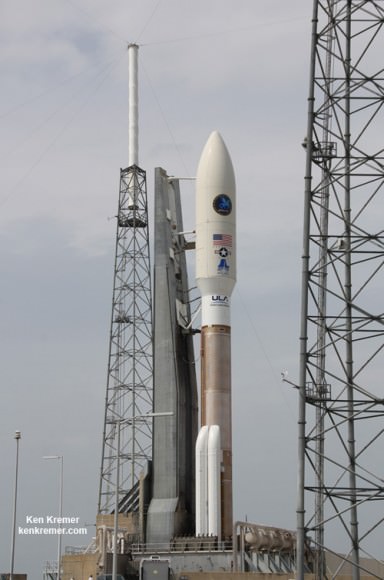
Musk wants his company’s newer and he says much cheaper Falcon 9 and Falcon Heavy rockets to be certified by the Air Force and included in the competition for launch contracts.
To date the Falcon 9 has launched only 9 times. Only four of those were in the new and more powerful configuration needed by the Air Force.
Musk is not asking that the launches be awarded outright to SpaceX. But he does want the Air Force contract cancelled and re-competed.
“We’re just protesting and saying that the launches should be competed,” Musk said.
“If we compete and lose that’s fine. But why were they not even competed? That just doesn’t make sense.”
“So far we are most of the way through the certification process. And so far there have been zero changes to the rocket. Mostly it’s just been a paperwork exercise.”
“Since this is a large multiyear contract, why not wait a few months for the certification process to complete. And then do the competition. That seems very reasonable to me.”
Musk said it costs four times more to launch ULA’s Delta or Atlas rocket vs. a SpaceX Falcon rocket.
“The ULA rockets are basically four times more expensive than ours. So this contract is costing US taxpayers billions of dollars for no reason.”
“Each launch by ULA costs American taxpayers roughly $400 million per launch. They are insanely expensive. I don’t know why they are so expensive.”
The Falcon 9 lists for about $60 Million per launch, but rises to about $100 million after the certification costs are included, Musk explained.
“So yes the certification does make our Falcon 9 rocket more expensive. But not 400% more expensive.”
“Our rockets are 21st century design,” said Musk to obtain the most efficiency. He said ULA’s designs date back to the 90s and earlier with heritage hardware.

To date the Falcon 9 has already been used three times under a $1.6 Billion contract with NASA to launch the private SpaceX Dragon resupply vessel to the International Space Station (ISS) – most recently a week ago during the April 18 blastoff of the SpaceX CRS-3 mission from Cape Canaveral.
It is also being used to launch highly expensive communications satellites like SES-8 and Thaicom-6 for private companies to geostationary orbits.
“It just seems odd that if our vehicle is good enough for NASA and supporting a $100 billion space station, and it’s good enough for launching NASA science satellites, for launching complex commercial geostationary satellites, then there’s no reasonable basis for it not being capable of launching something quite simple like a GPS satellite,” said Musk.
“Our only option is to file a protest.”
Furthermore as I wrote here in a prior article, US National Security launches are now potentially at risk due to the ongoing crisis between Russian, Ukraine and Crimea because the RD-180 first stage engines powering the Atlas V are designed and manufactured in Russia by NPO Energomash, majority owned by the Russian Federation.
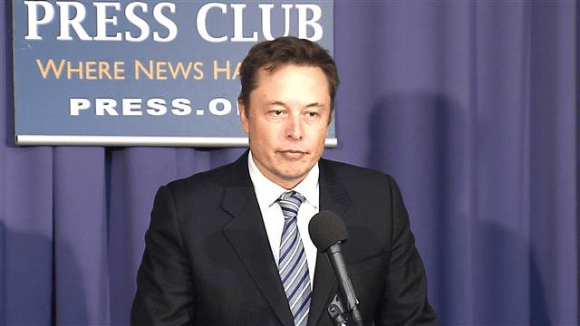
“The head of the Russian space sector, Dmitry Rogozin, was sanctioned by the White House in March 2014 in the wake of Russia’s aggression in Ukraine,” says SpaceX.
The RD-180 engine supply could be cut off in a worst case scenario if economic sanctions against Russia are increased by the Western allies.
ULA has a two year contingency supply of the RD-180’s and blueprints to begin production, if needed.
However in the event of a cutoff, it would take at least three to five years to start and certify RD-180 engine production somewhere in the US, a ULA spokesperson told me recently at Cape Canaveral.
This possibly leaves a 1 to 3 year gap with no Atlas V 1st stage engine supply.
The Delta IV rockets and engines by contrast are manufactured in the US.
“In light of international events, this seems like the wrong time to send hundreds of millions of dollars to the Kremlin,” said Musk.
“Yet, this is what the Air Force’s arrangement with ULA does, despite the fact that there are domestic alternatives available that do not rely on components from countries that pose a national security risk.”
Stay tuned here for Ken’s continuing SpaceX, Orbital Sciences, commercial space, Orion, Chang’e-3, LADEE, Mars rover, MAVEN, MOM and more planetary and human spaceflight news.
Weekly Space Hangout – April 25, 2014: Asteroids, ISS Repairs & an Annular Eclipse
Host: Fraser Cain
Guests: Morgan Rehnberg, Brian Koberlein, David Dickinson, Jason Major
This Week’s Stories:
Morgan Rehnberg (cosmicchatter.org / @cosmic_chatter):
EVA
Cosmos
SpaceX announcements
Brian Koberlein (@briankoberlein, briankoberlein.com):
Meteors are not more likely to hit Earth
Dave Dickinson (@astroguyz, www.astroguyz.com):
Saturn at Opposition
Bizarre Annular Eclipse
Jason Major (@JPMajor, LightsInTheDark.com):
B612 Foundation asteroid announcement
We record the Weekly Space Hangout every Friday at 12:00 pm Pacific / 3:00 pm Eastern. You can watch us live on Google+, Universe Today, or the Universe Today YouTube page.
Stunning Original Drawing of the Latest SpaceX Launch
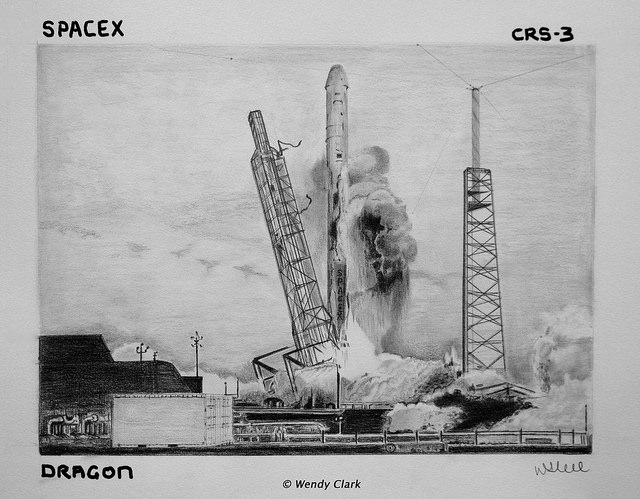
Here’s something you don’t see much anymore: an original pencil drawing of a launch. This drawing by Wendy Clark from the UK is reminiscent of the pre-spaceflight days, before we had actual images of launches, and just our dreams of spaceflight. This isn’t the first time Clark has drawn a launch (here’s an article we posted of her drawings of the MAVEN launch and the final space shuttle launch) but this one is almost a contrast in themes: the latest technology in launches from the upstart SpaceX team vs. an old-school, old fashioned, by-hand product.
For this drawing, she reiterated what she told us previously: “Don’t let anyone tell you drawing a rocket is easy!” Clark said on Flickr. “The Strongback was a complete dog of an object to draw, such a maze of engineering.”
She also captured the ‘dirty’ side of launches: “Dust and gravel being thrown up everywhere, and the lovely Falcon 9 rocket was a little grubby on lift-off and I’ve tried to reflect that in the drawing,” she said.
Thanks to Wendy Clark for sharing her work on Universe Today’s Flickr site. See more of her drawings and photography on her own Flickr page.
Easter Sunday Space Station Rendezvous and Berthing for SpaceX Dragon Freighter Successful
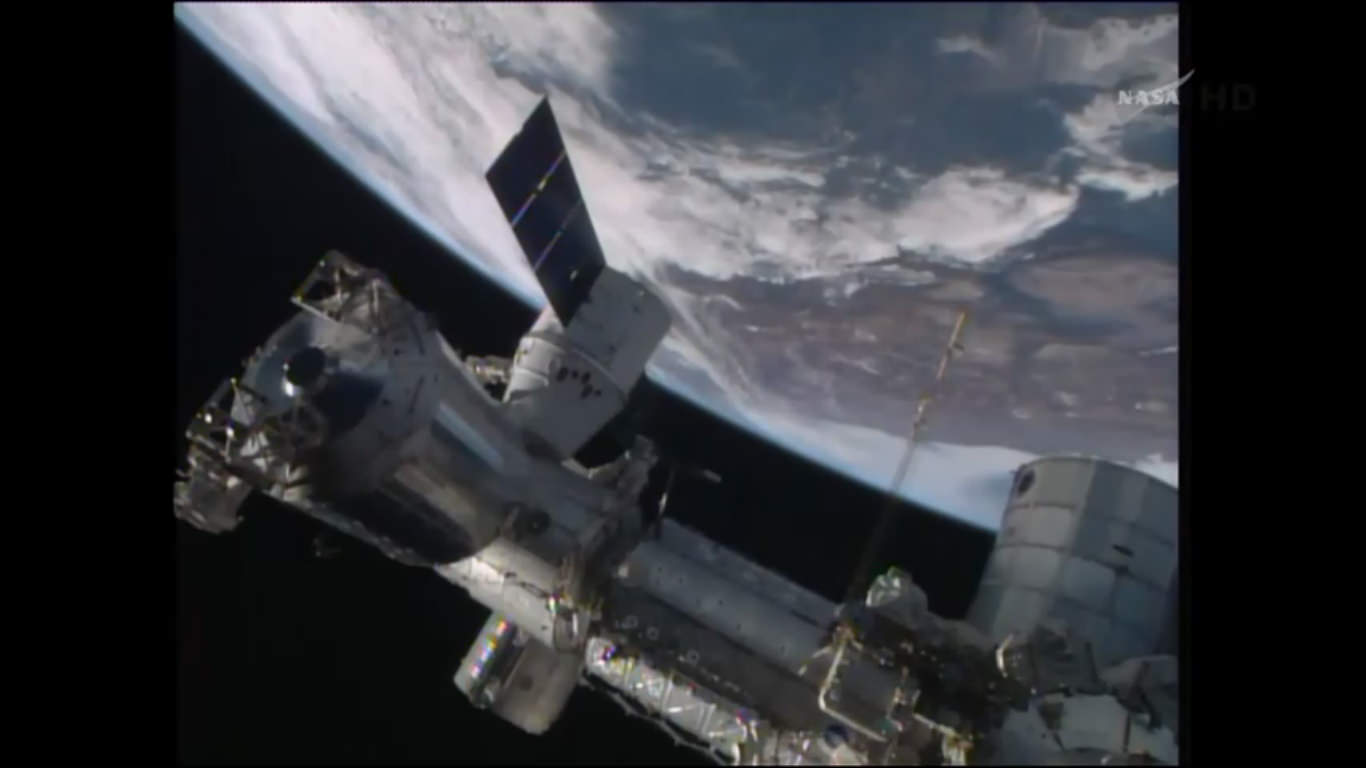
The SpaceX 3 Dragon commercial cargo freighter successfully arrived at the International Space Station (ISS) on Easter Sunday morning, April 20, as planned and was deftly captured by Expedition 39 Commander Koichi Wakata at 7:15 a.m. EDT at the controls of the Canadian built robotic arm.
The next step due shortly is berthing of Dragon at the Earth facing port of the Harmony module at approximately 9:30 a.m. EDT.
Berthing was officially completed at 10:06 a.m. EDT while the massive complex was soaring 260 miles above Brazil.
This story is being updated as events unfold. The mission is the company’s third cargo delivery flight to the station.
The Dragon vehicle loaded with nearly 2.5 tons of science experiments and supplies moved ever so slowly closely to within grappling distance – dramatically backdropped with gorgeous and ever changing scenery of our Home Planet sliding below.
The million pound orbiting lab complex and free flying SpaceX Dragon were soaring some 260 miles above Egypt and the Nile River as the 57 foot long robotic arm grappled the resupply ship.
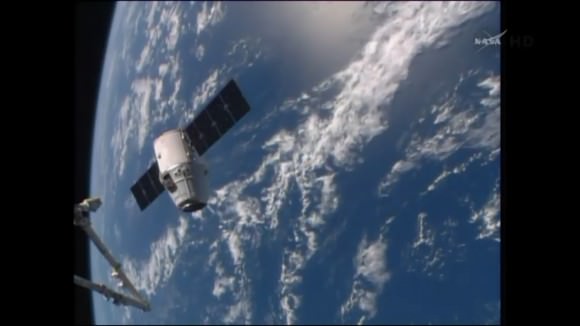
Dragon was approximately 30 feet (10 meters) away from the stations hull at the time of capture.
Wakata, of the Japan Aerospace Exploration Agency, was assisted by NASA astronaut Rick Mastracchio, while both were working from inside the 7 windowed Cupola robotics work station. Newly arrived NASA astronaut Steve Swanson observed the proceedings with a big smile.
“Congratulations to the entire ops team for the successful launch, rendezvous and capture of Dragon,” Wakata radioed mission control moments after the successful grapple.
“Great work catching the Dragon, enabling fantastic science,” radioed Capcom Steve Fisher from NASA Houston Mission Control.
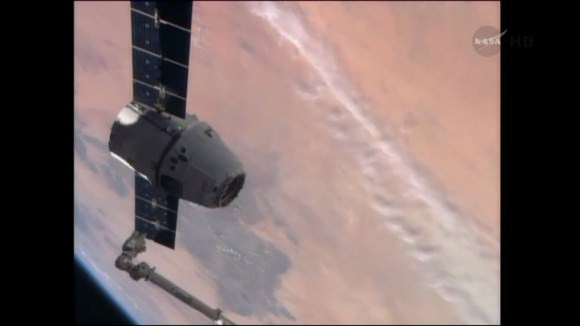
Cheers and celebrations erupted at SpaceX Mission Control at the firms headquarters in Hawthorne, Calif.
Dragon arrived this morning following Friday afternoons, Apr 18, spectacular blastoff from Cape Canaveral, Fla, atop an upgraded SpaceX Falcon 9 booster.
A two day orbital chase ensued with a series of critical engine burns targeting the ISS for Easter Sunday’s rendezvous and docking activities.
Rick Mastracchio was at the controls for the actual berthing and latching in place at Harmony with Dragon’s Common Berthing Mechanism (CBM).
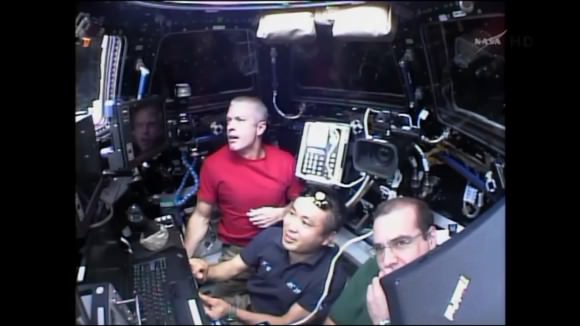
The berthing process started at about 9:30 a.m. EDT.
4 latches were driven for 1st stage of capture. Followed by all 16 bolts and latches in total during second stage capture to firmly hold Dragon in place.
The crew and mission control concluded the berthing procedure at 10:06 a.m. EDT flying over Brazil.
The next step is for the crew to pressurize the vestibule connecting Dragon to station.
Hatch opening is set to take place on Monday morning.
It’s a busy week ahead for the six person international crew representing the US, Russia and Japan.
A Russian Progress departs on Wednesday followed by the 2 person US spacewalk to replace the failed MDM unit.
Dragon will remain attached to the station until May 18.
This story is being updated. Check back.
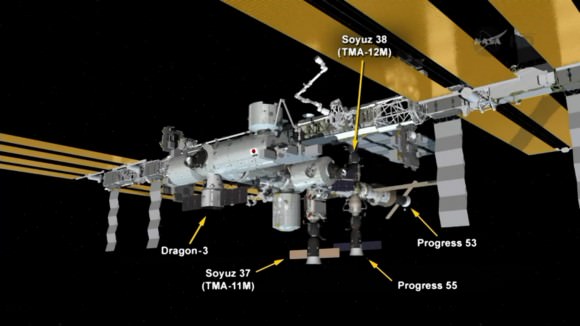
The SpaceX-3 mission marks the company’s third operational resupply mission to the ISS under a $1.6 Billion contract with NASA to deliver 20,000 kg (44,000 pounds) of cargo to the ISS during a dozen Dragon cargo spacecraft flights through 2016.
There are over 150 science experiments loaded aboard the Dragon capsule for research to be conducted by the crews of ISS Expeditions 39 and 40.
This unmanned SpaceX mission dubbed CRS-3 mission will deliver some 5000 pounds of science experiments, a pair of hi tech legs for Robonaut 2, a high definition Earth observing imaging camera suite (HDEV), a laser optical communications experiment (OPALS) and essential gear, the VEGGIE lettuce growing experiment, spare parts, crew provisions, food, clothing and supplies to the six person crews living and working aboard the ISS soaring in low Earth orbit under NASA’s Commercial Resupply Services (CRS) contract.
NASA TV coverage of the Easter Sunday grappling process began at 5:45 a.m. EDT with berthing coverage beginning at 9:30 a.m. EDT: http://www.nasa.gov/ntv
Stay tuned here for Ken’s continuing SpaceX, Orbital Sciences, commercial space, Orion, Chang’e-3, LADEE, Mars rover, MAVEN, MOM and more planetary and human spaceflight news.
Screenshots by Rob v. Mackelenbergh.
SpaceX Makes Strides Towards 1st Stage Falcon Rocket Recovery during Space Station Launch
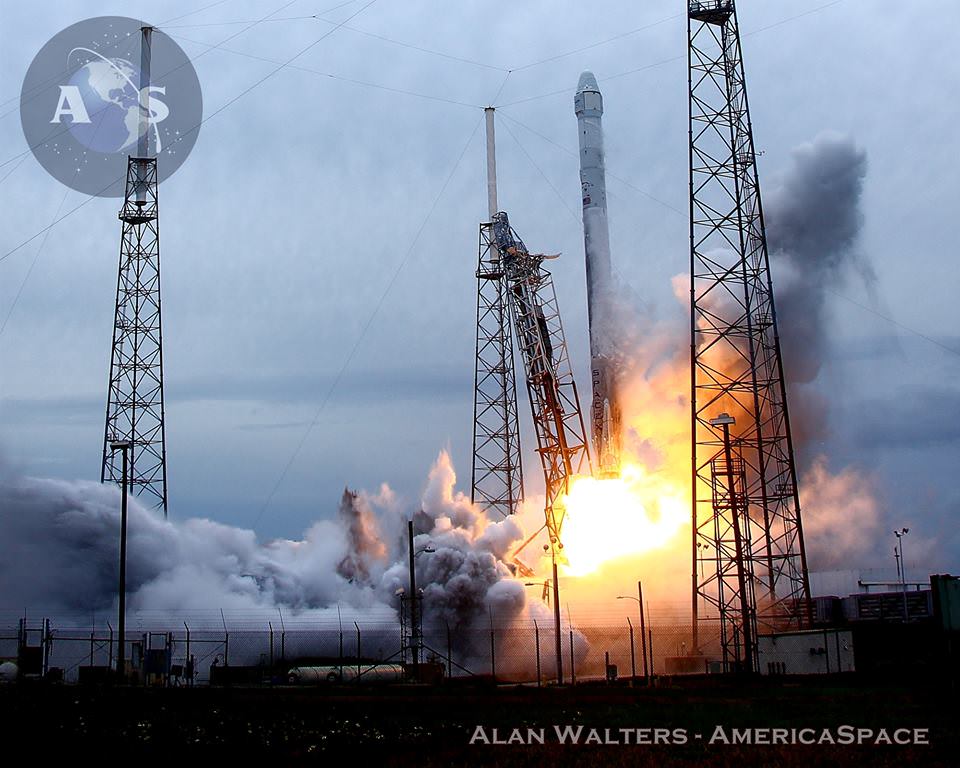
Blastoff of SpaceX Falcon 9 rocket from Cape Canaveral Air Force Station in Florida on April 18, 2014. Credit: Alan Walters/AmericaSpace
Story updated[/caption]
The powerful SpaceX Falcon 9 rocket that launched successfully on a cargo delivery run for NASA bound for the Space Station on Friday, April 18, from Cape Canaveral, Fla, also had a key secondary objective for the company aimed at experimenting with eventually recovering the rockets first stage via the use of landing legs and leading to the boosters refurbishment and reuse further down the road.
Marking a first of its kind test, this 20 story tall commercial Falcon 9 rocket was equipped with a quartet of landing legs to test controlled soft landing techniques first in the ocean and then back on solid ground at some later date this year or next – by reigniting the 1st stage engines for a guided touchdown.
The 12 foot diameter Falcon 9 rocket would sprout the legs just prior to water impact for the controlled soft landing in the Atlantic Ocean, guided by SpaceX engineers.
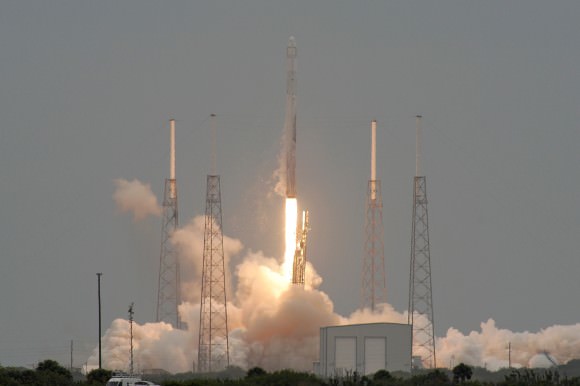
Prior to the launch SpaceX managers were careful not to raise expectations.
“The entire recovery of the first stage is completely experimental,” said Hans Koenigsmann, SpaceX vice president of mission assurance. “It has nothing to do with the primary mission.”
He estimated the odds of successfully retrieving an intact booster at merely 30 or 40 percent.
Following Friday’s blastoff, SpaceX reported they made significant strides towards that goal of a 1st stage recovery.
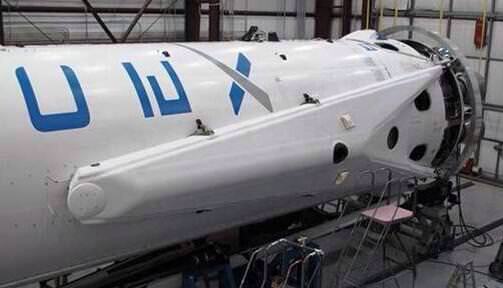
SpaceX engineers had preprogrammed the spent first stage to relight several Merlin 1 D engines after completing the boost phase and stage seperation to stabilize it, reduce its roll rate and then gradually lower its altitude back down to the Atlantic Ocean’s surface for a soft landing attempt and later possible recovery by retrieval ships.
All these critical steps seemed to go fairly well in initial reports that are subject to change.
SpaceX CEO and founder Elon Musk reported at a post launch briefing and later tweeted further updates that the Falcon 9 first stage actually made a good water landing despite rough seas, with waves swelling at least six feet.
“Roll rate close to zero (v important!).”
“Data upload from tracking plane shows landing in Atlantic was good! Several boats enroute through heavy seas,” Musk tweeted.
Furthermore he reported that the 1st stage survived the ocean touchdown.
“Flight computers continued transmitting for 8 seconds after reaching the water. Stopped when booster went horizontal.”
Because of the high waves, the recovery boats had difficulty reaching the booster in the recovery area located some two hundred miles off shore from Cape Canaveral.
Several previous attempts by SpaceX to recover the first stage via parachutes and thrusters were not successful. So SpaceX adopted this new approach with the landing legs and 1st stage Merlin 1 D engines.
Further details will be proved when they become available.
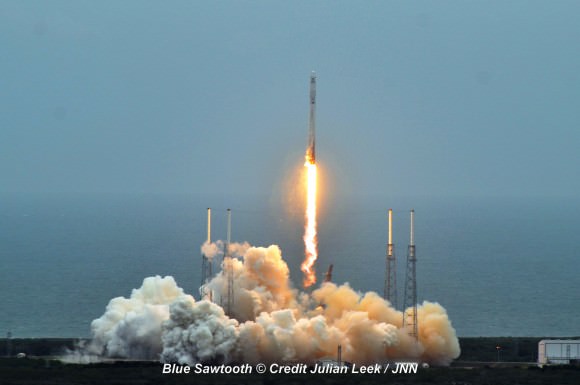
The attachment of the 25 foot long 1st stage landing legs to SpaceX’s next-generation Falcon 9 rocket for ocean recovery counts as a major step towards the firm’s future goal of building a fully reusable rocket and dramatically lowering launch costs compared to expendable boosters.
The eventual goal is to accomplish a successful first stage touchdown by the landing legs on solid ground back somewhere near on Cape Canaveral, Florida.
Musk said that SpaceX is still working out the details on finding a suitable landing location with NASA and the US Air Force.
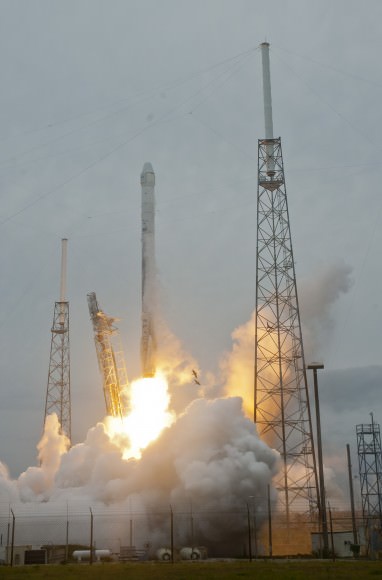
Extensive work and testing remains to develop and refine the technology before a land landing will be attempted by the company, says Musk.
It will be left to future missions to accomplish a successful first stage touchdown by the landing legs back on solid ground back through a series of ramped up rocket tests at Cape Canaveral, Florida.
“Even though we probably won’t get the stage back, I think we’re really starting to connect the dots of what’s needed,” Musk said at the briefing.
“There are only a few more dots that need to be there to have it all work. I think we’ve got a decent chance of bringing a stage back this year, which would be wonderful.”
Overall Musk was very pleased with the performance of the rocket and the landing leg test.
“I would consider it a success in the sense that we were able to control the boost stage to a zero roll rate, which is previously what has destroyed the stage, an uncontrolled roll, where the on-board nitrogen thrusters weren’t able to control the aerodynamic torque and spun up.”
“This time, with more powerful thrusters and more nitrogen propellant, we were able to null the roll rates.”
“I’m feeling pretty excited,” Musk stated. “This is a happy day. Most important of all is that we did a good job for NASA.”
This extra powerful new version of the Falcon 9 dubbed v1.1 is powered by a cluster of nine of SpaceX’s new Merlin 1D engines that are about 50% more powerful compared to the standard Merlin 1C engines. The nine Merlin 1D engines 1.3 million pounds of thrust at sea level rises to 1.5 million pounds as the rocket climbs to orbit.
Therefore the upgraded Falcon 9 can boost a much heavier cargo load to the ISS, low Earth orbit, geostationary orbit and beyond.
Indeed Dragon is loaded with nearly 5000 pounds of cargo, about double the weight carried previously.
If all goes well, Dragon will reach the ISS early on Easter Sunday morning after a two day orbital chase.
Station crew members Rick Mastracchio and Steven Swanson will grapple the Dragon cargo freighter with the 57 foot long Canadarm2 on Easter Sunday at about 7:14 a.m. and then berth it at the Earth-facing port of the Harmony module.
NASA TV coverage of the Easter Sunday grappling process will begin at 5:45 a.m. with berthing coverage beginning at 9:30 a.m. : http://www.nasa.gov/ntv
Stay tuned here for Ken’s continuing SpaceX, Orbital Sciences, commercial space, Orion, Chang’e-3, LADEE, Mars rover, MAVEN, MOM and more planetary and human spaceflight news.
Ken Kremer
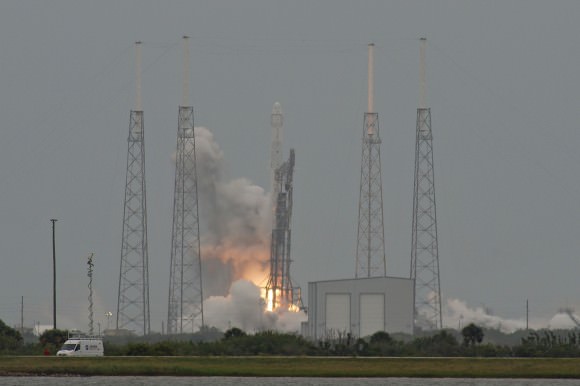
SpaceX Dragon Captured on Film in Orbit Over Paris 25 Minutes After Launch
UPDATE: Thanks to several people on Twitter who pointed out that what is seen in the footage here is the the upper stage of the Falcon 9, the Dragon capsule, and the ejected solar panel covers moving along together in orbit around the Earth. And as Phil Plait pointed out, since this was taken a few minutes after the capsule separated from the rocket upper stage, all the individual things you see here were still near each other in space.
We need to say it: astrophotographer Thierry Legault has done it again! Here’s an absolutely fantastic capture of the SpaceX Dragon capsule just 25 minutes after it launched from Cape Canaveral Air Force Station, as it passed over Europe. Here, Legault captured footage of Dragon crossing the Big Dipper as seen from Paris at 19:50 UTC, April 18, 2014.
“It was an incredible vision: 4 bright dots moving together!” Legault told Universe Today via email.
Check out more of his amazing astrophotography and even some of his tips and tricks at Thierry’s website.
SpaceX Commercial Dragon Resupply Ship Thunders to Space Bound for ISS and Easter Sunday Berthing – Photo Gallery
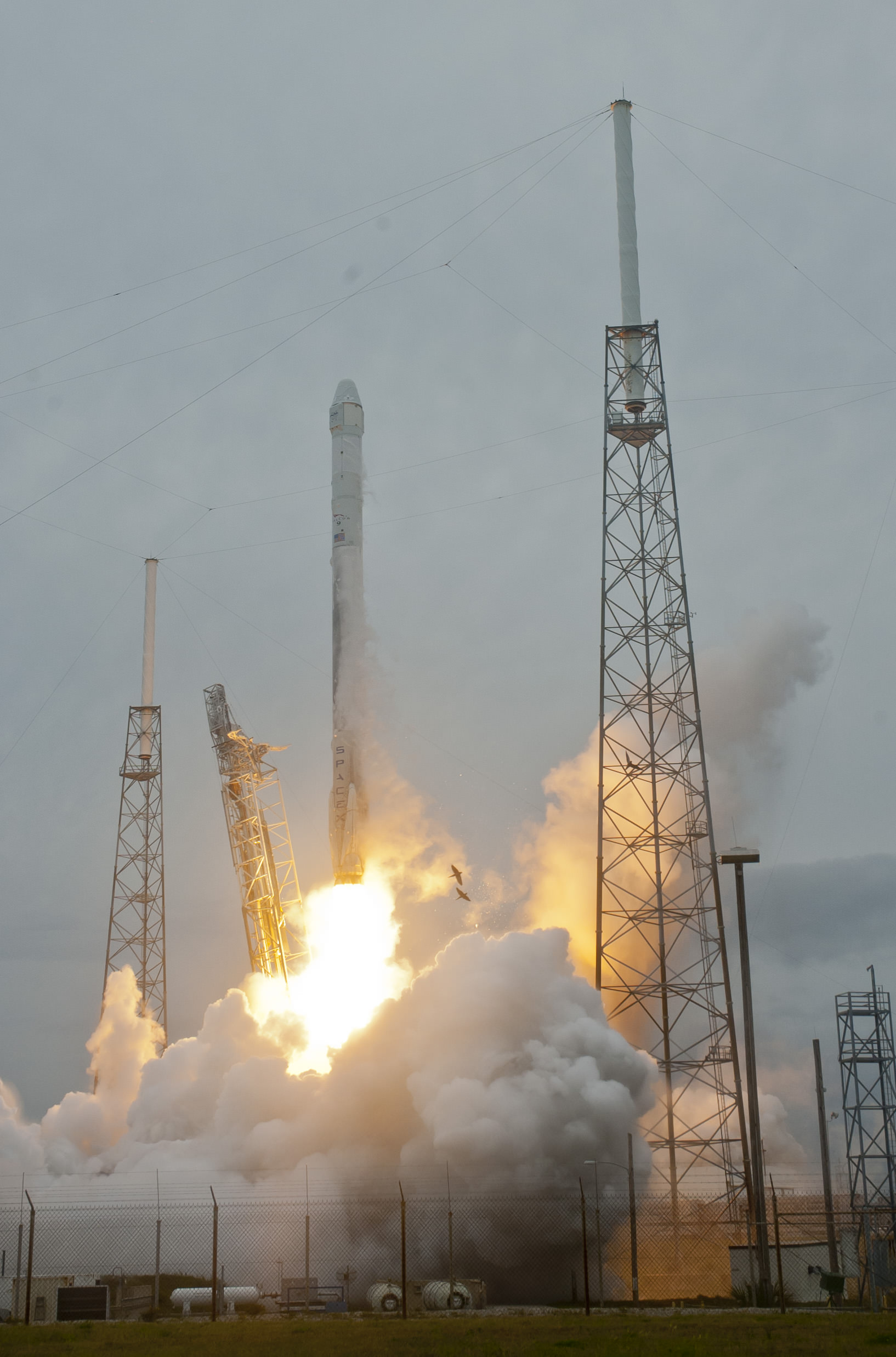
SpaceX Falcon 9 rocket and Dragon resupply ship launch from the Cape Canaveral Air Force Station in Florida on April 18, 2014. Credit: Jeff Seibert/Wired4Space
See expanding launch gallery below[/caption]
A mighty SpaceX rocket carrying the firms commercial Dragon resupply ship loaded with nearly 2.5 tons of NASA science instruments and critical supplies thundered to space this afternoon on a two day journey bound for the International Space Station.
The Dragon vessel launched atop the 20 story tall, upgraded Falcon 9 rocket from Space Launch Complex 40 at Cape Canaveral Air Force Station in Florida precisely on time at 3:25 p.m. EDT (1925 GMT), Friday, April 18.
“I want to congratulate SpaceX. Everyone did a great job” said William Gerstenmaier, NASA associate administrator for human exploration and operations, at a post launch briefing at the Kennedy Space Center press site.
“The SpaceX team went the extra mile to get everything ready for an on time launch.”
The spectacular blastoff went off without a hitch despite a poor weather prognosis in the morning that brightened considerably in the final hours leading up to the afternnon liftoff.
“Everything went well with the ascent,” said SpaceX CEO and founder Elon Muck at the briefing.
“I’m pretty excited. We did a good gob for our NASA customer and that’s very important,” Musk added.
The on time blastoff sets the stage for an Easter Sunday, April 20, rendezvous and berthing of the Dragon resupply spacecraft at the massive orbiting outpost packed with a striking variety of science experiments and needed supplies for the six person crew.
Station crew members Rick Mastracchio and Steven Swanson will grapple the Dragon cargo freighter with the 57 foot long Canadarm2 on Easter Sunday at about 7:14 a.m. if all goes well and then berth it at the Earth-facing port of the Harmony module.
The SpaceX-3 mission marks the company’s third resupply mission to the ISS under a $1.6 Billion contract with NASA to deliver 20,000 kg (44,000 pounds) of cargo to the ISS during a dozen Dragon cargo spacecraft flights through 2016.
There are over 150 science experiments loaded aboard the Dragon capsule for research to be conducted by the crews of ISS Expeditions 39 and 40.
“SpaceX is delivering important research experiments and cargo to the space station,” said Gerstenmaier.
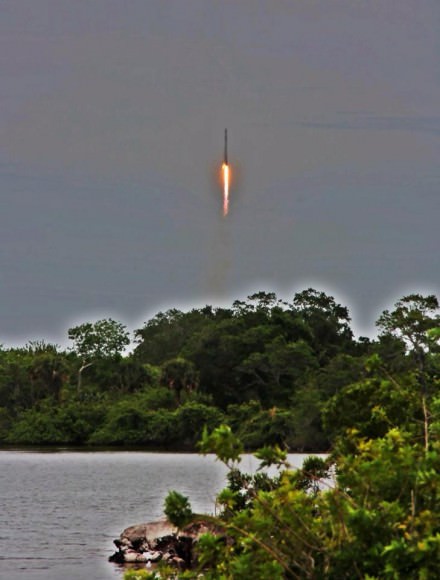
“The diversity and number of new experiments is phenomenal. The investigations aboard Dragon will help us improve our understanding of how humans adapt to living in space for long periods of time and help us develop technologies that will enable deep space exploration.”
This unmanned SpaceX mission dubbed CRS-3 mission will deliver some 5000 pounds of science experiments, a pair of hi tech legs for Robonaut 2, a high definition imaging camera suite, an optical communications experiment (OPALS) and essential gear, the VEGGIE lettuce growing experiment, spare parts, crew provisions, food, clothing and supplies to the six person crews living and working aboard the ISS soaring in low Earth orbit under NASA’s Commercial Resupply Services (CRS) contract.
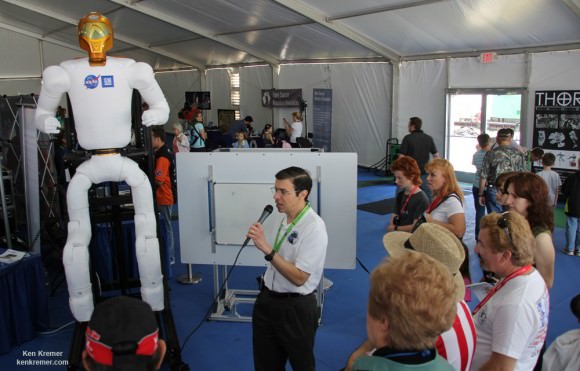
To date SpaceX had completed two operational cargo resupply missions and a test flight. The last flight dubbed CRS-2 blasted off a year ago on March 1, 2013 atop the initial version of the Falcon 9 rocket.
The next launch of Orbital Sciences Antares/Cygnus commercial rocket to the ISS from NASA Wallops, VA, was tentatively slated for May 6. But the target date will now slip to into mid-June since it can’t arrive until the Dragon departs.
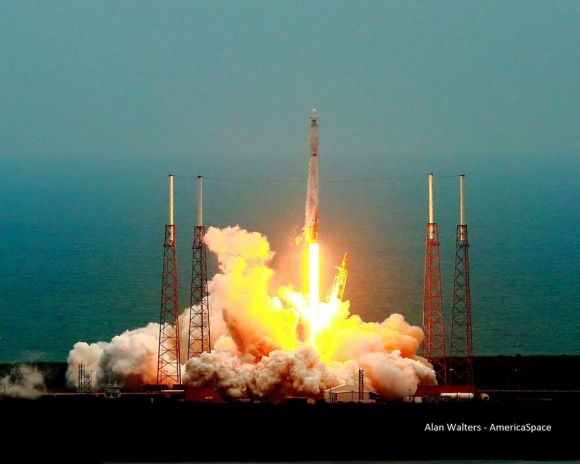
Both the Dragon and Antares dock at the same port on the Harmony module at the end of the station.
This extra powerful new version of the Falcon 9 dubbed v1.1 is powered by a cluster of nine of SpaceX’s new Merlin 1D engines that are about 50% more powerful compared to the standard Merlin 1C engines. The nine Merlin 1D engines 1.3 million pounds of thrust at sea level rises to 1.5 million pounds as the rocket climbs to orbit
Stay tuned here for Ken’s continuing SpaceX, Orbital Sciences, commercial space, Orion, Chang’e-3, LADEE, Mars rover, MAVEN, MOM and more planetary and human spaceflight news.
